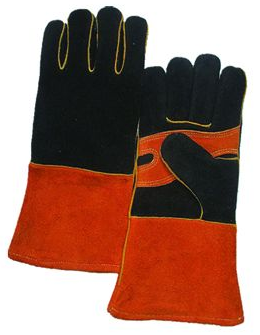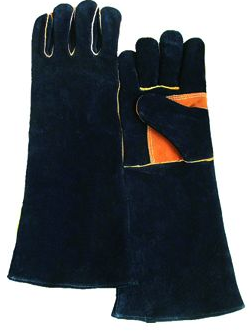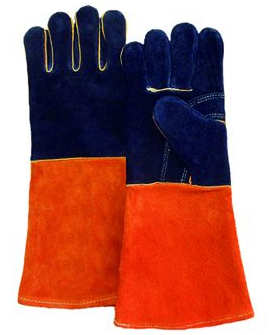Impact-resistant welding gloves are an essential part of any welder’s personal protective equipment for multiple reasons, the most obvious of which being that their hands are always closest to the actual act of welding. To get a more thorough understanding of the kinds of gloves welders to need to accomplish their jobs safely, let’s talk about why all welders need to wear gloves on the job.
Heat Resistance
Welders are known to work with intensive heat that’s capable of melting metals, so imagine the kind of burns and injuries that could occur if that flame of a welder came into contact with skin. This is the most basic function of a welder’s gloves, as their hands are always the closest body part to the flames and heat. However, the heat necessary for different materials can vary, and thus the material of your gloves will need to change.
If welding with over 90 amps, the gloves should have a Kevlar thread.
If over 125 amps, gloves should have cotton insulation.
If over 250 amps, gloves should have cotton and foam insulation
If over 500 amps, gloves should have a black hand pad or a reflective material on the back of the glove.

Physical Protection
Another reason why all welders need to wear gloves on the job is that welders will be using and working around a lot of intense and heavy machinery. Cuts, abrasions, blunt force, and more are common in such industrial settings, so even while they’re not welding, welders’ gloves protect their hands from physical damage. Another factor to consider is the weather and how it plays a role in a welder’s conditions. In the winter or when it’s particularly humid outside, the insulation within gloves will shield a welder’s hands from the cold or keep them dry from the blistering humidity.
Comfortable Fit
While you would think comfort should be sacrificed if it’s in favor of more protective measures, comfort is incredibly important. Welding is a grueling job, and the gloves need to not only protect the user from the welding process but from the lifestyle of the work environment itself. Because the job is particularly hard on one’s hands, welding gloves that are properly fitted will absorb sweat to prevent steam burns and reduce the stress, wear, and tear on your hands as you handle gear, material, and products. With a good pair of gloves, you shouldn’t have to end the day with hands that have gone raw and ragged from hard work.
Characteristics of High-Quality Gloves
When assessing the quality of the gloves you're comparing, several things need to be considered. Before we even talk about fit, the gloves must be hard-wearing and long-lasting to serve you well. Your glove should have a good lining, as well as good quality leather. Higher-quality leather will provide better levels of protection.
Welding gloves are made from multiple kinds of leather. These include elk skin, cowhide, deerskin, pigskin, and goatskin. Each type has different characteristics. One type of leather will be better for a certain type of welding than another one will be.
Also, look for good insulation. These are all signs of well-made, high-quality welding gloves. Keep these things in mind to help you get a pair that will both protect and last.

A Good Fit
Making sure your welding gloves fit well is just as important as how much they can protect you. If your hands are slipping out or you don't have enough room to move, you'll end up being uncomfortable as well as unsafe.
Look for gloves that aren't bulky and that provide you with freedom of movement. Your gloves should also be comfortable, so find ones that feel good to you.
Consider the type of thumb type you want. You can also choose between gloves that cover only the hand or extend all the way up over the elbow.
TIG Welding
The best TIG welding gloves provide a great amount of dexterity. Protection from heat and splattering isn't as high a priority as they need to be with other types of welding. It's more important for you to be able to perform your work with precision.
Goatskin gloves are a great choice for TIG welding. They provide durability while giving you the nimbleness you need. Keystone thumbs are a good option too.
To test your level of dexterity, put on a pair of gloves, then try to pick up something small, like a dime. If you have issues, look for a different pair.

MIG Welding
MIG welding exposes welding to more heat than TIG welding does, and you'll want to take splattering into consideration. You'll also need protection from lots of sparks.
Lines goat or cow grain gloves, or gloves made from heavier-weight cow split gloves are both great options. The best MIG welding gloves will be durable as well as protective against harmful spatters, sparks, and heat.
Stick Welding
The best stick welding gloves will be extremely heavy duty. If you're doing this type of welding, you'll need the highest level of protection!
Lots of really high heat and lots of splattering must be taken into consideration as you choose your gloves. But, you won't need to worry as much about dexterity.
Gloves that cover more than just your hands are worth your consideration here. You'll also want a really good lining.
Heavyweight cow split leather gloves work well for stick welding.
For further technical information talk with our specialist or visit our website https://www.sino-welding.com. We can help you to identify the best solution for your application.








